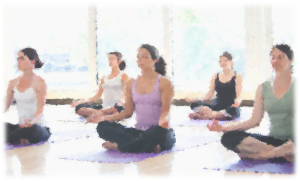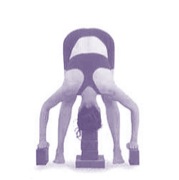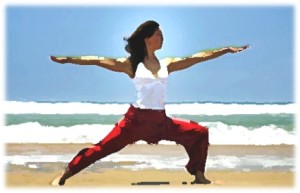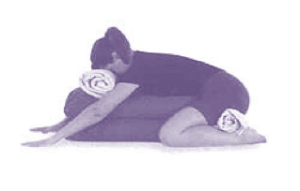Have you been looking for a relaxing, restorative and healing yoga sequence you can practice at home?
I created this specific yoga sequence upon request for a friend and would like to share this soothing practice with you. Allow me to invite you to take some time for yourself, and start indulging in this soothing and restorative yoga practice.
The following yoga poses (asanas) are supporting your overall wellbeing as well as beneficial for menstruation (toning and regulating), side effects of menopause, thyroid imbalance and high blood pressure.
Before you start, please have some yoga blocks (or you can use stacked books), a bolster (or towels and blankets) handy.
 (Cautions: If you have osteoarthritis of the knees, a fever or diarrhea – DO NOT PRACTICE this. If you have low blood pressure please come out of these poses gradually to avoid dizziness. )
(Cautions: If you have osteoarthritis of the knees, a fever or diarrhea – DO NOT PRACTICE this. If you have low blood pressure please come out of these poses gradually to avoid dizziness. )
To prepare, place some yoga blogs on your mat or the floor, underneath your head and hands, when bending forward.
Start by standing in Mountain Pose (Tadasana).
Place your feet about hip width apart and parallel to each other. Lift your kneecaps up and let your tailbone drop down. Draw your shoulder blades together, arms by your sides, fingertips reaching toward the floor.
Inhale your arms up overhead, palms facing each other, extend your spine up.
 Exhale as you bend from your hips toward the floor, bending your knees as much as you need to, coming into a Forward Fold (Uttanasana). To increase the stretch in your spine make sure to press your heels down.
Exhale as you bend from your hips toward the floor, bending your knees as much as you need to, coming into a Forward Fold (Uttanasana). To increase the stretch in your spine make sure to press your heels down.
To make this pose restorative, rest the crown of your head on the stacked blocks and your hands on the blocks next to your feet.
Lift your thigh muscles to spread the sitbones, aim to get the tailbone higher than your lower back.
Breathe deeply and stay in this pose for about one minute.
 Come down onto hands and knees. Remove all blocks from the top of your mat but keep one block handy. Walk your hands a few inches toward the top of the mat, tuck your toes under and lift yourself back and up into Downward Facing Dog (Adhomukha Svanasana).
Come down onto hands and knees. Remove all blocks from the top of your mat but keep one block handy. Walk your hands a few inches toward the top of the mat, tuck your toes under and lift yourself back and up into Downward Facing Dog (Adhomukha Svanasana).
If you have high blood pressure, are prone to headaches or have a stiff spine, practice this pose with your head supported by a block. Place the block under your head and rest your head on the block keeping the neck in line with your spine.
Draw your thigh muscles up and press your hands equally into your mat while you draw your heels back (they don’t have to touch the floor). Breathe deep and stay for a couple of breaths, when ready, come back down to your hands and knees.
Special benefits of Downward Facing Dog:
This pose helps to rest and rejuvenate the heart, relieves headaches and hypertension, increases self-confidence and reduces the feeling of heavy-headedness associated with menopause.
Coming into Supta Baddhakonasana or Reclining fixed angle pose
From hands and knees come to sit with your legs stretched out in front of you. Place a bolster (or a few folded and stacked towels or blankets) behind your buttocks. Place an additional towel or pillow for extra comfort on the far side of the bolster to rest your head on.
Bend your knees and draw the soles of your feet together. Place blocks or folded towels/blankets under your knees until your knees can rest on the support without causing discomfort. Place your elbows on the floor, then lower your back and head onto the bolster, ensuring that the length of your spine and head is fully supported and on the center of the bolster. When ready release your arms to the sides, allowing your palms to open to the ceiling. Slow your breath and relax into this very restorative pose. Initially it is recommended to start staying in this pose for about 1 minute. With practice please feel free to increase the duration to about 5-10 minutes, making sure you come out of the pose very gently and slowly. To come out of the pose bring your knees together and your elbows on the floor. When you are ready gently push yourself up to sitting.
Adhomukha Virasana
Place the bolster (blankets/towels) in front of you, placing a rolled towel or blanket on the top part to rest your forehead on.
Place another rolled towel or blanket across your heels as you kneel with the bolster between your knees. Draw your feet together and take a few deep breaths, letting your buttocks rest on the rolled up towel.
When you feel ready place your hands on either side of the bolster and slowly lower your torso down. Let your forehead rest on the rolled up towel while you slide your arms forward, palms facing down. Push your chest forward and your thighs down, lowering your buttocks toward the floor. Continue to stretch your torso and arms forward while continuing to relax your body down. Initially stay in this pose for about one minute. When you feel ready, go ahead and increase the duration to about 5-10 minutes, coming out of the pose slowly and gently. To come out gently bring your arms back under your shoulders and push yourself up.
To make this total relaxation pose as restorative and supportive as possible for you, place the bolster (blankets/towels) behind your buttocks and a folded towel on the top end of the bolster to rest your head on. If you wish, place a rolled up blanket under your knees to relieve your lower back.
Sit with your buttocks as close as you can toward the short end of the bolster. When you are ready, place your hands on the floor and slowly lower yourself onto the bolster with your spine on the center of the bolster.
Relax your shoulders and let your arms drop to your sides, palms facing up. Allow your legs to relax and your feet to drop out to the sides. Gently close your eyes. Continue to relax your forehead, eyes, throat, chest, abdomen, arms and legs, letting your body absorb your practice. Stay in the pose for 5 – 10 minutes.
To come out of the pose, gently roll off the bolster onto your right side, bending your knees. Pause for a few breaths. When you feel ready push into your left hand to very slowly and gently come up to sitting, letting the head and neck come up last. Find a comfortable seated position, keeping your eyes closed and take another few deep breaths. When you are ready, gently open your eyes.
NAMASTÉ










